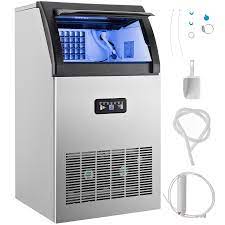Introduction
In various industries, the reliance on a steady and high-quality ice supply is indispensable. Commercial ice machines serve as the cornerstone of numerous businesses, offering a diverse array of options to fulfill specific demands. Understanding the functionalities, types, considerations, and maintenance protocols associated with commercial ice machines is essential for businesses seeking reliable and efficient ice production solutions. This comprehensive guide aims to navigate the intricacies of commercial ice machines, providing insights to assist businesses in making well-informed decisions when investing in these vital pieces of equipment.
Types of Commercial Ice Machines:
- Modular Ice Machines: Comprising separate ice-making heads and storage bins, modular machines are ideal for high-volume ice production, allowing flexibility in storage capacities.
- Undercounter Ice Machines: Compact and designed to fit beneath counters, these units provide a dedicated ice-making solution for establishments with limited space requirements.
- Countertop Ice Makers: Portable and space-saving, these machines cater to smaller-scale operations or serve as supplementary ice sources in offices, cafes, or bars.
- Ice Dispensers: Focused on dispensing ice rather than production, these machines are commonly found in self-service environments, providing convenient access to ice.
Key Considerations When Choosing Commercial Ice Machines:
- Production Capacity: Assess the anticipated demand and select a machine capable of meeting or exceeding peak requirements without compromising performance.
- Ice Type and Quality: Different machines produce various ice types—cubes, flakes, nuggets, or specialty forms. Choose based on the specific needs of your business, such as beverage presentation or preservation purposes.
- Storage Capacity and Dispensing Mechanism: Align storage or dispensing features with production capacity to ensure a continuous and adequate ice supply during peak hours.
- Space and Installation Requirements: Evaluate available space and consider installation necessities like water supply, drainage, and ventilation for seamless integration.
- Energy Efficiency: Opt for models with energy-saving features to reduce operational costs and environmental impact over time.
- Ease of Maintenance: Choose machines with accessible components for easy cleaning and maintenance, ensuring hygienic ice production and prolonged machine lifespan.
Maintenance and Care:
Regular maintenance is crucial for the longevity and optimal performance of commercial ice machines. Adhere to manufacturer-recommended cleaning schedules, including descaling, sanitization, and filter replacements, to maintain peak functionality and hygiene.
Conclusion:
Selecting a Commercial ice machines involves a meticulous evaluation of production capacity, ice type, storage requirements, installation needs, and budget considerations. By aligning these factors with the specific operational demands of your business, you can make informed decisions, procuring a commercial ice machine that seamlessly integrates into your workflow, ensuring a consistent and superior ice supply essential for success in your industry.



